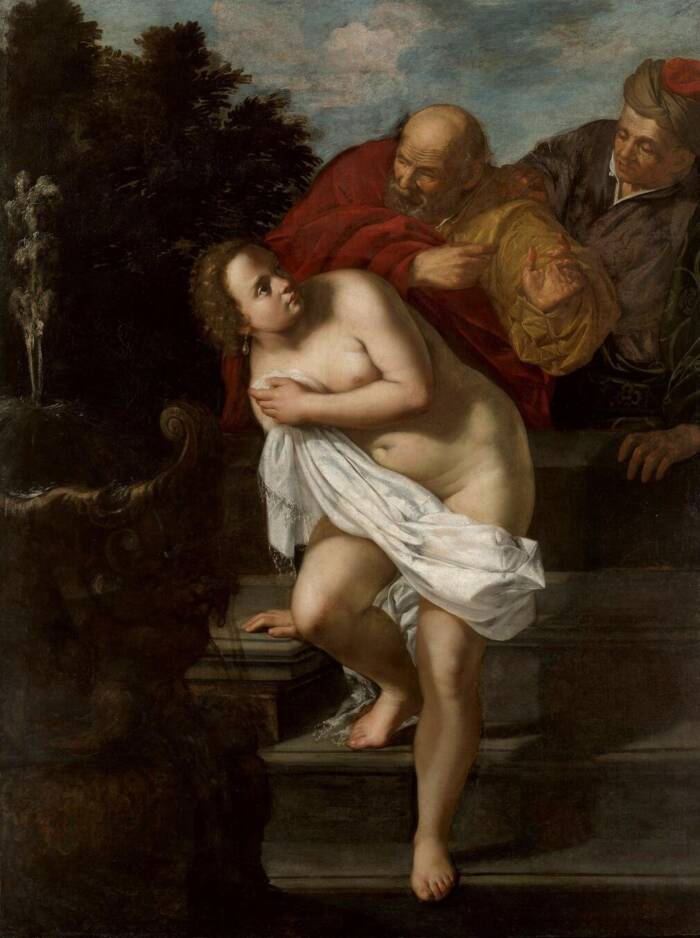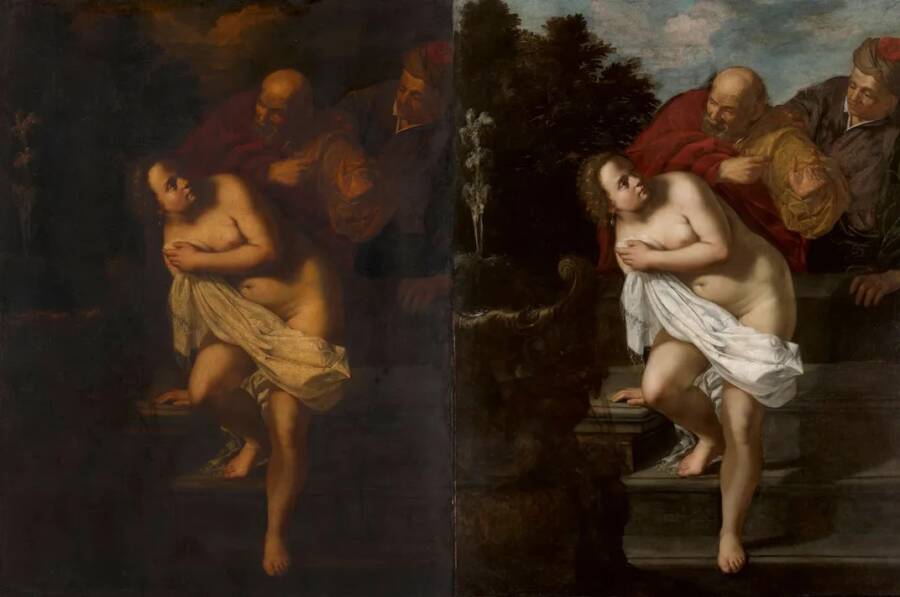The painting, which depicts the biblical story of Susanna, was in such poor condition that it was almost unrecognizable.

Royal Collection TrustConservator Adelaide Izat working on the rediscovered painting, Susanna and the Elders.
Around 200 years ago, a painting by one of the most celebrated female artists of the 17th century, Artemisia Gentileschi, was misattributed to a male artist. It was subsequently forgotten and tucked away in a storeroom in Hampton Court Palace — until art historians rediscovered it decades later. However, it was in such poor condition that it was hardly recognizable.
Curators from the King’s Royal Collection Trust were ultimately able to identify the rare Artemisia piece by matching it to a description found in the inventory of King Charles I.
“It’s once in a generation that we might come across something of this importance that we haven’t registered,” Anna Reynolds, deputy surveyor of the King’s Pictures, told the Telegraph.
A team led by art historian Niko Munz had been looking into what had happened to Charles I’s collection after his execution in 1649. Their research found that the king had owned seven paintings by Artemisia Gentileschi, but only one, Self-Portrait as the Allegory of Painting (La Pittura), was thought to have survived.
“We had the description and we had other references in inventories, but the painting that was in store really didn’t look like an Artemisia Gentileschi because it was so heavily overpainted and the varnish was so discolored,” Reynolds said.
Gentileschi had, in fact, painted the subject six times over the course of her career, and the unique way in which she depicted the famous biblical scene was partly what enabled curators to identify the painting.
Gentileschi’s Susanna is shown cowering, with her body turned away from the men. In contrast, many of her male contemporaries often depicted the scene in a more sexualized manner.
“It’s hard not to read into that subject,” Reynolds said. “It’s about a woman being spied on and effectively blackmailed if she doesn’t agree to their advances. She’ll be accused of adultery, which in itself would lead to the death penalty, but she is ultimately proven innocent, and becomes a symbol of truth and innocence.”

Royal Collection TrustSusanna and the Elders by Italian artist Artemisia Gentileschi.
There may be a personal reason for Gentileschi’s depiction of Susanna in this way. As Reynolds explained, when Artemisia Gentileschi was just 17 years old, she was raped by another artist, Agostino Tassi, who had been working in her father’s studio. At his trial, Gentileschi was forced to testify against him and was “tortured” to prove that she was telling the truth.
As Reynolds told The Guardian, “[Gentileschi] seems to have felt a close affinity with Susanna.”
In the five years since its rediscovery, Gentileschi’s painting has undergone extensive restoration work.
“We were going through the inventories and Dr. Niko noted one that was like something kept in the Hampton Court store for more than 100 years,” Reynolds said. “It was incredibly brown and discolored, as often happens with organic varnish. Its size had also been increased with strips of sewn-on canvas, which could have been the reason for all the over-painting. It was only once we started to see the work underneath that a few special elements stood out.”
One of the biggest clues was the use of lead tin antimony yellow paint, which had been one of Gentileschi’s favorites to use.

Royal Collection TrustSusanna and the Elders as it appeared when it was rediscovered (left) compared to the now-complete restoration (right).
Curators now have some sense of what likely happened to the painting. They believe the piece was first commissioned by Charles I’s wife, Henrietta Maria of France. A 1639 inventory by the king’s surveyor, Abraham van der Doort, shows that the painting initially hung above a fireplace in the queen’s withdrawing chamber at Whitehall Palace.
Around 1660, curators believe the painting was moved to Somerset House and placed above another fireplace. By the late 18th century, though, interest in Baroque paintings had largely fallen away, and Gentileschi’s fame had started to wane.
The painting was later moved to Kensington Palace, as evidenced by a watercolor of the queen’s bedchamber in 1819, which depicts Susanna and the Elders propped against a wall.
The painting was transferred once again, this time to Hampton Court Palace, though it no longer had its frame. An 1862 inventory described the work as being “in a bad state,” and it was sent for restoration, which is when the additional layers of varnish were applied.
By then, Gentileschi’s painting had already lost its attribution, and the work was largely disregarded.
“This complete rediscovery of an artist as important as Artemisia having been lost is really quite unusual,” Reynolds said. “I think it’s linked to the fact that her reputation in the 18th century declined. She really was a trailblazer, she was very unique, partly because the opportunities for training women artists just weren’t the same as they were for men.”
Paintings conservator Adelaide Izat told the Telegraph that when the painting came into her studio, it was “the most heavily overpainted canvas I had ever seen, its surface almost completely obscured.”
Izat continued, “It has been incredible to be involved in returning the painting to its rightful place in the Royal Collection, allowing viewers to appreciate Artemisia’s artistry again for the first time in centuries.”
After learning about the rediscovery of the long-lost Artemisia Gentileschi painting, read about the recent listing of Bob Ross’ first on-air painting for nearly $10 million. Or, learn about the “cursed” painting that was returned to a UK thrift shop twice — then sold online for $2,000.





